Scientific name
Exoristobia philippinensis Ashmead
Taxonomic position
Hymenoptera: Chalcidoidea: Encyrtidae: Encyrtinae
Diagnosis
Body more or less uniform black with a metallic tinge; antenna with scape yellowish, remaining segments dark brown to black; legs yellowish brown, femora slightly darker; wings hyaline. Mandibles with three nearly equal teeth. Antenna (Fig. 1) with 6-segmented funicle, all funicular segments
transverse, club three-segmented, apically obliquely truncate. Compound eyes with conspicuous, dense hairs.
Mesoscutum with deep reticulate sculpture, scutellum with much shallower reticulate sculpture. Cercal plates situated at about middle of gaster (Fig. 3). Fore wing with marginal vein longer than broad; postmarginal vein much shorter than stigmal vein (Fig. 2). Only species under Exoristobia known from India. Parasitic on many dipterous hosts, particularly tachinids.
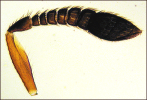 Fig. 1. Antenna Fig. 1. Antenna
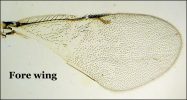 Fig. 2. Fore wing Fig. 2. Fore wing
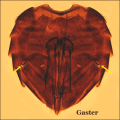 Fig. 3. Abdomen (arrow marks indicate cercal plates, situated around middle of abdomen) Fig. 3. Abdomen (arrow marks indicate cercal plates, situated around middle of abdomen)
Images

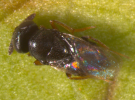
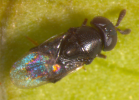 Adult - dorsal view Adult - dorsal view
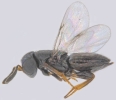 Adult - lateral view Adult - lateral view
Distribution
Widely distributed in the Oriental region. India (Karnataka); Sri Lanka; Myanmar; Philippines; Papua New Guinea.
Hosts / Biology
It is a gregarious larval-pupal endoparasitoid of the Indian Uzi fly, Exorista
bombycis (=Tricholyga bombycis), a pest of mulberry silkworm, Bombyx mori. Also parasitic on many dipterous hosts belonging to Tachinidae, Muscidae, Sarcophagidae, etc.
References
- Ashmead, W.H. 1904. A list of the Hymenoptera of the Philippine Islands with descriptions of new species. Journal of the New York Entomological Society, 12: 1-22.
- Hayat, M. 2006. Indian Encyrtidae (Hymenoptera: Chalcidoidea). Department of Zoology, Aligarh Muslim University, India. vii+496 p.
|